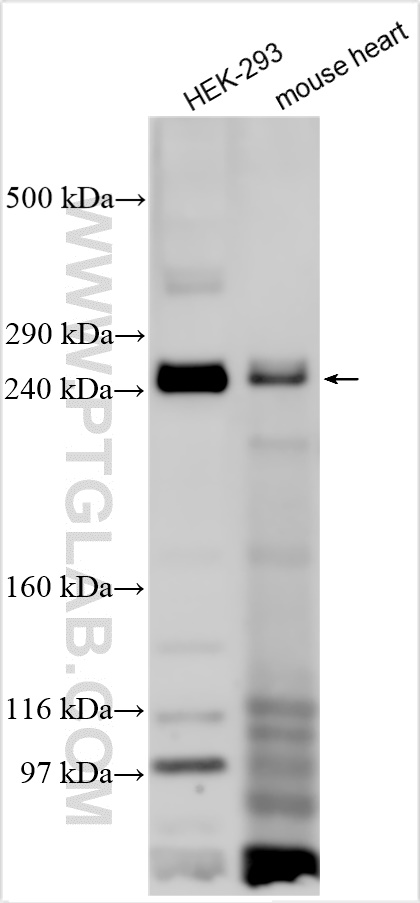验证数据展示
经过测试的应用
| Positive WB detected in | HEK-293 cells |
| Positive IF-P detected in | mouse brain tissue |
推荐稀释比
| 应用 | 推荐稀释比 |
|---|---|
| Western Blot (WB) | WB : 1:500-1:2000 |
| Immunofluorescence (IF)-P | IF-P : 1:50-1:500 |
| It is recommended that this reagent should be titrated in each testing system to obtain optimal results. | |
| Sample-dependent, Check data in validation data gallery. | |
产品信息
27551-1-AP targets SCN2A in WB, IF-P, ELISA applications and shows reactivity with human, mouse samples.
| 经测试应用 | WB, IF-P, ELISA Application Description |
| 经测试反应性 | human, mouse |
| 免疫原 | SCN2A fusion protein Ag26022 种属同源性预测 |
| 宿主/亚型 | Rabbit / IgG |
| 抗体类别 | Polyclonal |
| 产品类型 | Antibody |
| 全称 | sodium channel, voltage-gated, type II, alpha subunit |
| 别名 | Na(v)1.2, HBSCII, HBSCI, HBSC II, HBA |
| 计算分子量 | 228 kDa |
| 观测分子量 | ~250 kDa |
| GenBank蛋白编号 | NM_001040142 |
| 基因名称 | SCN2A |
| Gene ID (NCBI) | 6326 |
| RRID | AB_3085969 |
| 偶联类型 | Unconjugated |
| 形式 | Liquid |
| 纯化方式 | Antigen affinity purification |
| UNIPROT ID | Q99250 |
| 储存缓冲液 | PBS with 0.02% sodium azide and 50% glycerol pH 7.3. |
| 储存条件 | Store at -20°C. Stable for one year after shipment. Aliquoting is unnecessary for -20oC storage. |
背景介绍
The Sodium Channel, Voltage-Gated, Type II, Alpha (SCN2A) gene encodes the neuronal sodium channel NaV1.2. There are two major developmentally regulated splice isoforms of NaV1.2 that use mutually exclusive copies of the fifth coding exon and differ by one amino acid at position 209: Asparagine (Asn/N) vs. Aspartic acid (Asp/D). NaV1.2 is one of several sodium channels involved in initiation and propagation of action potentials in neurons. It's widely expressed throughout the human central nervous system, but not in peripheral tissues. (PMID: 29691040)
实验方案
| Product Specific Protocols | |
|---|---|
| WB protocol for SCN2A antibody 27551-1-AP | Download protocol |
| IF protocol for SCN2A antibody 27551-1-AP | Download protocol |
| Standard Protocols | |
|---|---|
| Click here to view our Standard Protocols |

